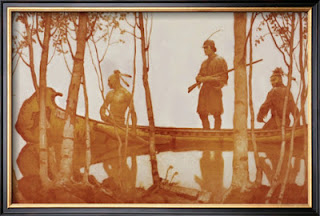After a positive reception to Monday's post on a 'colonial hex crawl', I started sketching out the ideas this week for it, and I'm really warming to the idea as a mini-project.
I like hex crawls that involve mostly human encounters, because of the wide open possibilities for negotiation and parley in lieu of fight, fight, fight. The American wilds in the early 17th century had a scattering of frontier forts and trading posts of the Dutch and French, colonies for the Dutch, English, and Swedish, and larger French settlements in Quebec and Montreal. The native Algonquin and Iroquois populations are both allies and antagonists, and the two nations themselves were made of tribes that competed with each other. I'm envisioning a wilderness where common encounters could involve patrols of soldiers associated with a fort; fur trappers; traders and merchants; natives of many types - farmers, hunters, traders, and warriors; various Christian missionaries - English Protestant or French Catholic.
The frontier suggests a portable alternate to the gold piece economy - animal furs and pelts were the major currency between Europeans and the natives. There are plenty of sources that lay out the value of beaver pelts vis-à-vis common goods. Returning home with stacks of pelts instead of gold pieces and gems is flavorful.
It's easy to map standard classes to period archetypes - fighters and specialists are soldiers, hunters, trappers, outdoorsman, and native guides; clerics are missionaries or native shaman; magic users represent witches, warlocks, and hermetic scholars that have engaged with the dark powers. (They should probably stay away from Plymouth, or Salem.) I don’t have strong opinions on the demi human classes, yet, but will probably make them Old World rarities or isolated throwbacks.
Okay, great, I have an idea to make an early modern period work as a frontier hex crawl - what makes it over the top?
 |
*The awesome Wendigo interpretation is by Monkey Paw on deviant art


The Iroquois have some fantastic legendary monsters -- I did my senior thesis on the idea that the Iroquois mythologized the remains of prehistoric creatures they'd discovered. Stone Giants are a good one -- giant, ogre-like cannibals covered with a stony exoskeleton -- and then there's things like Horned Lake Serpents, giant demon mosquitoes, giant flying heads, etc.
ReplyDeleteCool! Great to see more of this.
ReplyDeleteBrutally nice... Keep it coming!
ReplyDeleteA very enticing time period for an RPG setting, Beedo. Care to work it into a PbP? :D
ReplyDeleteThoughts for demi-human classes (not completely Politically Correct, mind you, but being PC is hardly something the Grue bothers himself with)...
I was in a modern-era OD&D PbP a while back where the GM handled at least the elf demi-human class by portraying them as one who was indigenous to the Americas (e.g. Native American or Mayan). I can see where that isn't terribly politically correct (a Native American being a sub-species), but... it worked.
When it came to the dwarf demi-human, I believe he equated it to a slightly shorter backwater type, generally from someplace like the Appalachians. I'm somewhat partial to Anne Rice's take on the dwarf demi-human as portrayed in Taltos. Honestly, that might offer a way of resolving the elf demi-human class, as well, without demeaning any native cultures.
I like those ideas Grue - working the demi-humans into near-extinct backwater races in the new world.
ReplyDeleteThere's the Mannegishi if you need dwarves and hobbits.
ReplyDeleteAs for elves... well, there's really one obvious choice for nature-dwelling humanoids.
What a fascinating concept!
ReplyDelete